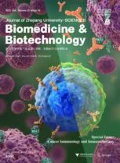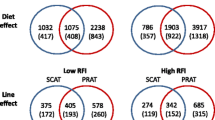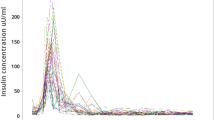Abstract
Because of their physiological similarity to humans, pigs provide an excellent model for the study of obesity. This study evaluated diet-induced adiposity in genetically lean pigs and found that body weight and energy intake did not differ between controls and pigs fed the high-fat (HF) diet for three months. However, fat mass percentage, adipocyte size, concentrations of total cholesterol (TC), triglyceride (TG), high-density lipoprotein cholesterol (HDL-C) and low-density lipoprotein cholesterol (LDL-C), insulin, and leptin in plasma were significantly higher in HF pigs than in controls. The HF diet increased the expression in backfat tissue of genes responsible for cholesterol synthesis such as Insig-1 and Insig-2. Lipid metabolism-related genes including sterol regulatory element binding protein 1c (SREBP-1c), fatty acid synthase 1 (FASN1), diacylglycerol O-acyltransferase 2 (DGAT2), and fatty acid binding protein 4 (FABP4) were significantly up-regulated in backfat tissue, while the expression of proliferator-activated receptor-α (PPAR-α) and carnitine palmitoyl transferase 2 (CPT2), both involved in fatty acid oxidation, was reduced. In liver tissue, HF feeding significantly elevated the expression of SREBP-1c, FASN1, DGAT2, and hepatocyte nuclear factor-4α (HNF-4α) mRNAs. Microarray analysis further showed that the HF diet had a significant effect on the expression of 576 genes. Among these, 108 genes were related to 21 pathways, with 20 genes involved in adiposity deposition and 26 related to immune response. Our results suggest that an HF diet can induce genetically lean pigs into obesity with body fat mass expansion and adipose-related inflammation.
中文概要
目的
研究高脂膳食是否会引起瘦肉型猪肥胖。
创新点
发现给瘦肉型猪饲喂高脂膳食, 会引起其脂肪沉积, 同时导致肥胖及脂肪炎症。
方法
采用化学组织切片技术测量脂肪细胞和肌肉细胞的直径、体积及密度基因芯片检测瘦肉型杜长大猪脂肪组织相关基因的变化荧光定量聚合酶链反应(qPCR)技术检测脂肪和肝脏组织中Insig-1、Insig-2、HMGCR、SREBP-1c、HNF-4α、FASN1、DGAT1、DGAT2、FABP4、CPT1、CPT2、PPAR-γ及PPAR-α等基因表达水平采用血浆生化指标仪试剂盒检测猪血浆中甘油三酯、葡萄糖、总胆固醇、高密度脂蛋白胆固醇、低密度蛋白胆固醇、胰岛素及瘦素的含量。
结论
结果表明, 高脂膳食增加瘦肉型猪的脂肪质量, 增大脂肪细胞, 而且增加血浆中总胆固醇、甘油三酯、高密度脂蛋白胆固醇、低密度脂蛋白胆固醇、胰岛素和瘦素的含量。高脂膳食增加背部脂肪组织中Insig-1、Insig-2、SREBP-1c、FASN1、 DGAT2 和FABP4 等正调节脂肪生成的基因表达量, 但下调PPAR-α 和CPT2 的表达。在肝脏组织中, 高脂膳食上调SREBP-1c、FASN1、DGAT2 和HNF-4α 基因表达。此外, 基因芯片分析的结果发现高脂膳食上调了脂肪组织中576个基因的表达水平, 其中20个基因涉及到脂肪生成, 26 个基因与脂肪炎症相关。综上所述, 高脂膳食可以引起瘦肉型猪的脂肪沉积并导致肥胖且伴随脂肪炎症。
Similar content being viewed by others
References
Azorín-Ortuño M, Yáñez-Gascón MJ, González-Sarrías A, et al., 2012. Effects of long-term consumption of low doses of resveratrol on diet-induced mild hypercholesterolemia in pigs: a transcriptomic approach to disease prevention. J Nutr Biochem, 23(7):829–837. https://doi.org/10.1016/j.jnutbio.2011.04.007
Bernlohr DA, Jenkins AE, Bennaars AA, 2002. Adipose tissue and lipid metabolism. In: Vance DE, Vance JE (Eds.), Biochemistry of Lipids, Lipoproteins and Membranes, 4th Ed. Elsevier, Amsterdam, p.263–289.
Bortell R, Owen TA, Ignotz R, et al., 1994. TGFβ1 prevents the down-regulation of type I procollagen, fibronectin, and TGFβ1 gene expression associated with 3T3-L1 preadipocyte differentiation. J Cell Biochem, 54(2):256–263. https://doi.org/10.1002/jcb.240540214
Bray GA, Paeratakul S, Popkin BM, 2004. Dietary fat and obesity: a review of animal, clinical and epidemiological studies. Physiol Behav, 83(4):549–555. https://doi.org/10.1016/j.physbeh.2004.08.039
Campión J, Milagro FI, Fernández D, et al., 2006. Diferential gene expression and adiposity reduction induced by ascorbic acid supplementation in a cafeteria model of obesity. J Physiol Biochem, 62(2):71–80. https://doi.org/10.1007/BF03174068
Chalkley SM, Hettiarachchi M, Chisholm DJ, et al., 2002. Long-term high-fat feeding leads to severe insulin resistance but not diabetes in Wistar rats. Am J Physiol Endocrinol Metab, 282(6):e1231–E1238. https://doi.org/10.1152/ajpendo.00173.2001
Choi EH, Yang HP, Chun HS, 2012. Chitooligosaccharide ameliorates diet-induced obesity in mice and affects adipose gene expression involved in adipogenesis and inflammation. Nutr Res, 32(3):218–228. https://doi.org/10.1016/j.nutres.2012.02.004
Christoffersen B, Golozoubova V, Pacini G, et al., 2013. The young Göttingen minipig as a model of childhood and adolescent obesity: influence of diet and gender. Obesity, 21(1):149–158. https://doi.org/10.1002/oby.20249
Gimeno RE, Klaman LD, 2005. Adipose tissue as an active endocrine organ: recent advances. Curr Opin Pharmacol, 5(2):122–128. https://doi.org/10.1016/j.coph.2005.01.006
Gregoire FM, Smas CM, Sul HS, 1998. Understanding adipocyte differentiation. Physiol Rev, 78(3):783–809. https://doi.org/10.1152/physrev.1998.78.3.783
Guilford BL, Parson JC, Grote CW, et al., 2017. Increased FNDC5 is associated with insulin resistance in high fat-fed mice. Physiol Rep, 5(13):e13319. https://doi.org/10.14814/phy2.13319
Kershaw EE, Flier JS, 2004. Adipose tissue as an endocrine organ. J Clin Endocrinol Metab, 89(6):2548–2556. https://doi.org/10.1210/jc.2004–0395
Kim Y, Park T, 2010. DNA microarrays to define and search for genes associated with obesity. Biotechnol J, 5(1): 99–112. https://doi.org/10.1002/biot.200900228
Leitner L, Schuch K, Jürets A, et al., 2015. Immunological blockade of adipocyte inflammation caused by increased matrix metalloproteinase-cleaved osteopontin in obesity. Obesity, 23(4):779–785. https://doi.org/10.1002/oby.21024
Li JZ, Ye J, Xue BF, et al., 2007. Cideb regulates diet-induced obesity, liver steatosis, and insulin sensitivity by controlling lipogenesis and fatty acid oxidation. Diabetes, 56(10): 2523–2532. https://doi.org/10.2337/db07-0040
Liu Y, Millar JS, Cromley DA, et al., 2008. Knockdown of Acyl-CoA: diacylglycerol acyltransferase 2 with antisense oligonucleotide reduces VLDL TG and ApoB secretion in mice. Biochim Biophys Acta, 1781(3):97–104. https://doi.org/10.1016/j.bbalip.2008.01.001
Liu YQ, Yuan JF, Xiang L, et al., 2017. A high sucrose and high fat diet induced the development of insulin resistance in the skeletal muscle of Bama miniature pigs through the Akt/GLUT4 pathway. Exp Anim, 66(4): 387–395. https://doi.org/10.1538/expanim.17-0010
Ludvigsen TP, Kirk RK, Christoffersen BØ, et al., 2015. Göttingen minipig model of diet-induced atherosclerosis: influence of mild streptozotocin-induced diabetes on lesion severity and markers of inflammation evaluated in obese, obese and diabetic, and lean control animals. J Transl Med, 13:312. https://doi.org/10.1186/s12967-015-0670-2
Ma XY, Zheng CT, Hu YJ, et al., 2015. Dietary L-arginine supplementation affects the skeletal longissimus muscle proteome in finishing pigs. PLoS ONE, 10(1):e0117294. https://doi.org/10.1371/journal.pone.0117294
Malbert CH, Picq C, Divoux JL, et al., 2017. Obesityassociated alterations in glucose metabolism are reversed by chronic bilateral stimulation of the abdominal vagus nerve. Diabetes, 66:848–857. https://doi.org/10.2337/db16-0847
Munzberg H, 2010. Leptin-signaling pathways and leptin resistance. In: Langhans W, Geary N (Eds.), Frontiers in Eating and Weight Regulation. Karger, Switzerland, p.123–132.
Nakajima I, Muroya S, Tanab RI, et al., 2002. Extracellular matrix development during differentiation into adipocytes with a unique increase in type V and VI collagen. Biol Cell, 94(3):197–203. https://doi.org/10.1016/S0248-4900(02)01189-9
O'Hea EK, Leveille GA, 1969. Significance of adipose tissue and liver as sites of fatty acid synthesis in the pig and the efficiency of utilization of various substrates for lipogenesis. J Nutr, 99(3):338–344. https://doi.org/10.1093/jn/99.3.338
Pasarica M, Gowronska-Kozak B, Burk D, et al., 2009. Adipose tissue collagen VI in obesity. J Clin Endocrinol Metab, 94(12):5155–5162. https://doi.org/10.1210/jc.2009-0947
Qiu YQ, Yang XF, Ma XY, et al., 2017. CIDE gene expression in adipose tissue, liver, and skeletal muscle from obese and lean pigs. J Zhejiang Univ-Sci B (Biomed & Biotechnol), 18(6):492–500. https://doi.org/10.1631/jzus.B1600294
Rocha D, Plastow G, 2006. Commercial pigs: an untapped resource for human obesity research? Drug Discov Today, 11(11–12): 475–477. https://doi.org/10.1016/j.drudis.2006.04.009
Rødgaard T, Stagsted J, Christoffersen BØ, et al., 2013. Orosomucoid expression profiles in liver, adipose tissues and serum of lean and obese domestic pigs, Göttingen minipigs and Ossabaw minipigs. Vet Immunol Immunopathol, 151(3–4): 325–330. https://doi.org/10.1016/j.vetimm.2012.11.002
Schrauwen P, Westerterp KR, 2000. The role of high-fat diets and physical activity in the regulation of body weight. Br J Nutr, 84(4):417–427. https://doi.org/10.1017/S0007114500001720
Soukas A, Cohen P, Socci ND, et al., 2000. Leptin-specific patterns of gene expression in white adipose tissue. Genes Dev, 14(8):963–980.
Toedebusch RG, Roberts MD, Wells KD, et al., 2014. Unique transcriptomic signature of omental adipose tissue in Ossabaw swine: a model of childhood obesity. Physiol Genomics, 46(10):362–375. https://doi.org/10.1152/physiolgenomics.00172.2013
Weiner FR, Shah A, Smith PJ, et al., 1989. Regulation of collagen gene expression in 3T3-L1 cells. Effects of adipocyte differentiation and tumor necrosis factor α. Biochemistry, 28(9):4094–4099. https://doi.org/10.1021/bi00435a070
Yang SC, Lin SH, Chang JS, et al., 2017. High fat diet with a high monounsaturated fatty acid and polyunsaturated/saturated fatty acid ratio suppresses body fat accumulation and weight gain in obese hamsters. Nutrients, 9(10): 1148. https://doi.org/10.3390/nu9101148
Yaqoob P, Sherrington EJ, Jeffery NM, et al., 1995. Comparison of the effects of a range of dietary lipids upon serum and tissue lipid composition in the rat. Int J Biochem Cell Biol, 27(3):297–310. https://doi.org/10.1016/1357-2725(94)00065-J
Acknowledgements
We gratefully acknowledge Dr. WB Currie (Cornell University, Ithaca, NY, USA) for suggestions on presentation.
Author information
Authors and Affiliations
Corresponding author
Additional information
Project supported by the National Key Research and Development Program of China (Nos. 2018YFD0500400 and 2018YFD0501100), the National Basic Research Program (973) of China (No. 2013CB127304), the China Agriculture Research System (No. CARS-36), and the National Natural Science Foundation of China (No. 31402086)
Electronic supplementary material
11585_2018_316_MOESM1_ESM.pdf
A high-fat diet increases body fat mass and up-regulates expression of genes related to adipogenesis and inflammation in a genetically lean pig
Rights and permissions
About this article
Cite this article
Yang, Xf., Qiu, Yq., Wang, L. et al. A high-fat diet increases body fat mass and up-regulates expression of genes related to adipogenesis and inflammation in a genetically lean pig. J. Zhejiang Univ. Sci. B 19, 884–894 (2018). https://doi.org/10.1631/jzus.B1700507
Received:
Accepted:
Published:
Issue Date:
DOI: https://doi.org/10.1631/jzus.B1700507
Key words
- Genetically lean pig
- Diet-induced obesity
- High-fat diet
- Adiposity deposition
- Microarray analysis
- Inflammation




